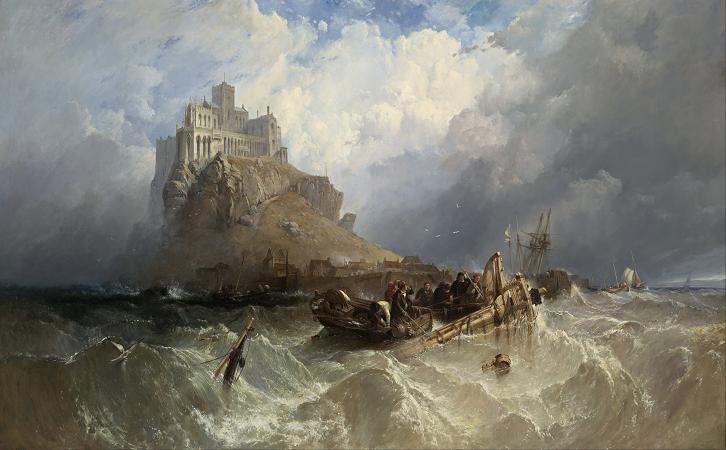Saint Michael's Mount. St Michael's Mount is a tidal island in Mount's Bay, Cornwall, England, United Kingdom. The island is a civil parish and is linked to the town of Marazion by a man-made causeway of granite setts, passable between mid-tide and low water. It is managed by the National Trust, and the castle and chapel have been the home of the St Aubyn family since approximately 1650. Historically, St Michael's Mount was a Cornish counterpart of Mont Saint-Michel in Normandy, France, when it was given to the Benedictine religious order of Mont Saint-Michel by Edward the Confessor in the 11th century. St Michael's Mount is one of 43 unbridged tidal islands that one can walk to from mainland Britain. Part of the island was designated as a Site of Special Scientific Interest in 1995 for its geology. Its Cornish language name, literally, the grey rock in a wood, may represent a folk memory of a time before Mount's Bay was flooded, indicating a description of the mount set in woodland. Remains of trees have been seen at low tides following storms on the beach at Perranuthnoe. There is evidence of people living in the area during the Neolithic. The key discovery was of a leaf-shaped flint arrowhead, which was found within a shallow pit on the lower eastern slope, now part of the modern gardens. Other pieces of flint have been found, and at least two could be Mesolithic. During the Mesolithic, Britain was still attached to mainland Europe via Doggerland, and archaeologist and prehistorian Caroline Malone noted that during the Late Mesolithic, the British Isles were something of a technological backwater in European terms, still living as a hunter-gatherer society whilst most of southern Europe had already taken up agriculture and sedentary living. At this time the mount would likely to have been an area of dry ground surrounded by a marshy forest. Any Neolithic or Mesolithic camps are likely to have been destroyed by the later extensive building operations, but it is reasonable to expect the mount to have supported either a seasonal or short-term camp for Mesolithic people. None of the flints, so far recovered, can be positively dated to the Bronze Age, although any summit cairns would have most likely been destroyed when building the castle. Radiocarbon dating established the submerging of the hazel wood at about 1700 BC. A hoard of copper weapons, once thought to have been found on the mount, are now thought to have been found on nearby Marazion Marsh. Defensive stony banks on the north-eastern slopes are likely to date to the early 1st millennium BC, and are considered to be a cliff castle. The mount is one of several candidates for the island of Ictis, described as a tin trading centre in the Bibliotheca historica of the Sicilian-Greek historian Diodorus Siculus, writing in the first century BC. St Michael's Mount may have been the site of a monastery from the 8th to the early 11th centuries. Edward the Confessor gifted the site to the Benedictine order of Mont Saint-Michel and it was a priory of that abbey until the dissolution of the alien houses as a side-effect of the war in France by Henry V, when it was given to the Abbess and Convent of Syon at Isleworth, Middlesex in 1424. Thus ended its association with Mont St Michel, and any connection with Looe Island. It was a destination for pilgrims, whose devotions were encouraged by an indulgence granted by Pope Gregory in the 11th century. The earliest buildings on the summit, including a castle, date to the 12th century. Sir Henry de la Pomeroy captured the Mount in 1193, on behalf of Prince John, in the reign of King Richard I. The monastic buildings were built during the 12th century. Various sources state that the earthquake of 1275 destroyed the original Priory Church, although this may be a misunderstanding of the term St Michael's on the Mount which referred to the church of St Michael atop Glastonbury Tor. Syon Abbey, a monastery of the Bridgettine Order acquired the Mount in 1424. Some 20 years later the mount was granted by Henry VI to King's College, Cambridge on its foundation. However when Edward IV took the throne during the Wars of the Roses the mount was returned to the Syon Abbey in 1462. John de Vere, 13th Earl of Oxford, seized and held it during a siege of 23 weeks against 6,000 of Edward IV's troops in 1473-74. Perkin Warbeck, a pretender to the English throne, occupied the Mount in 1497. Sir Humphrey Arundell, Governor of St Michael's Mount, led the Prayer Book Rebellion of 1549.
more...



